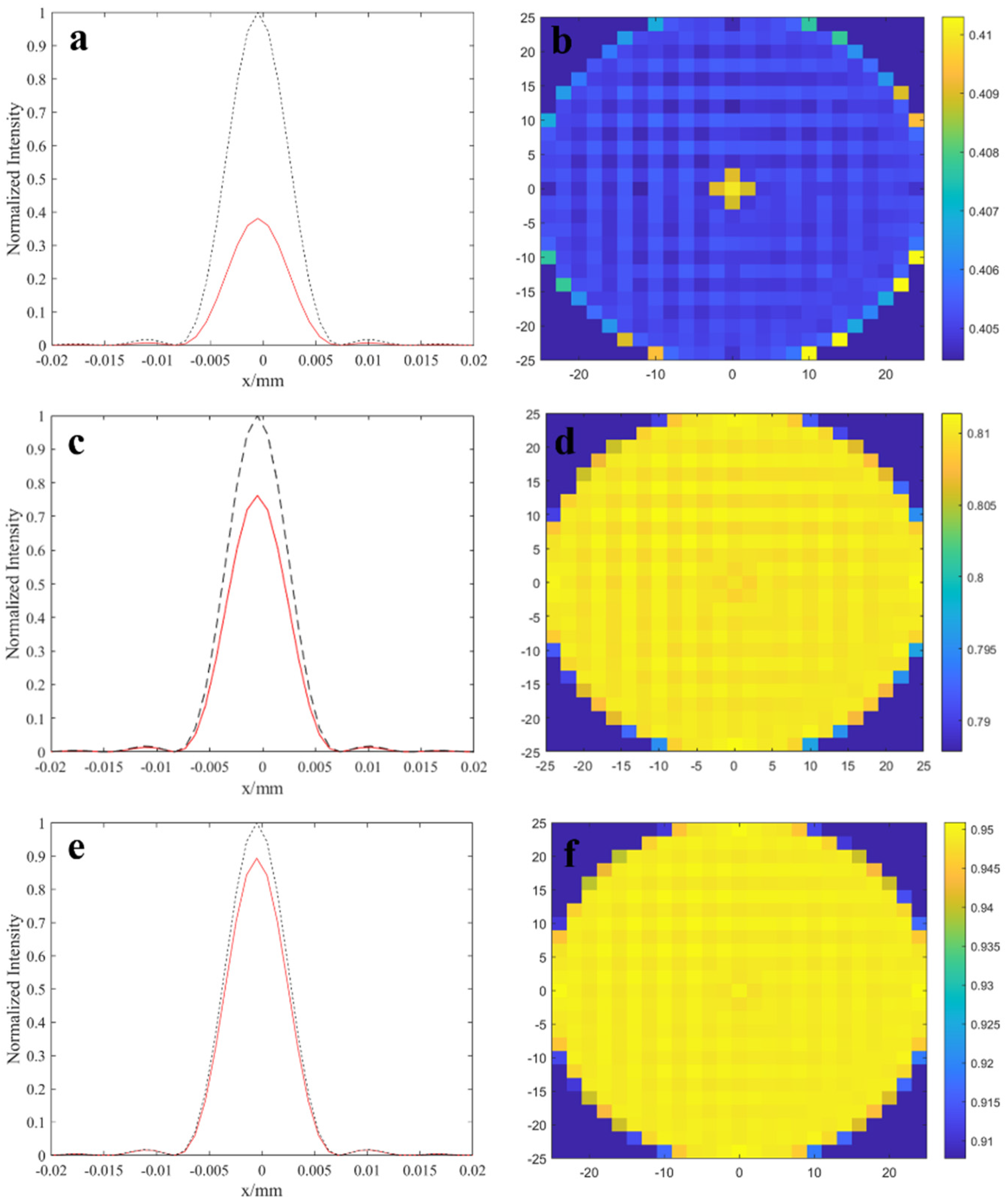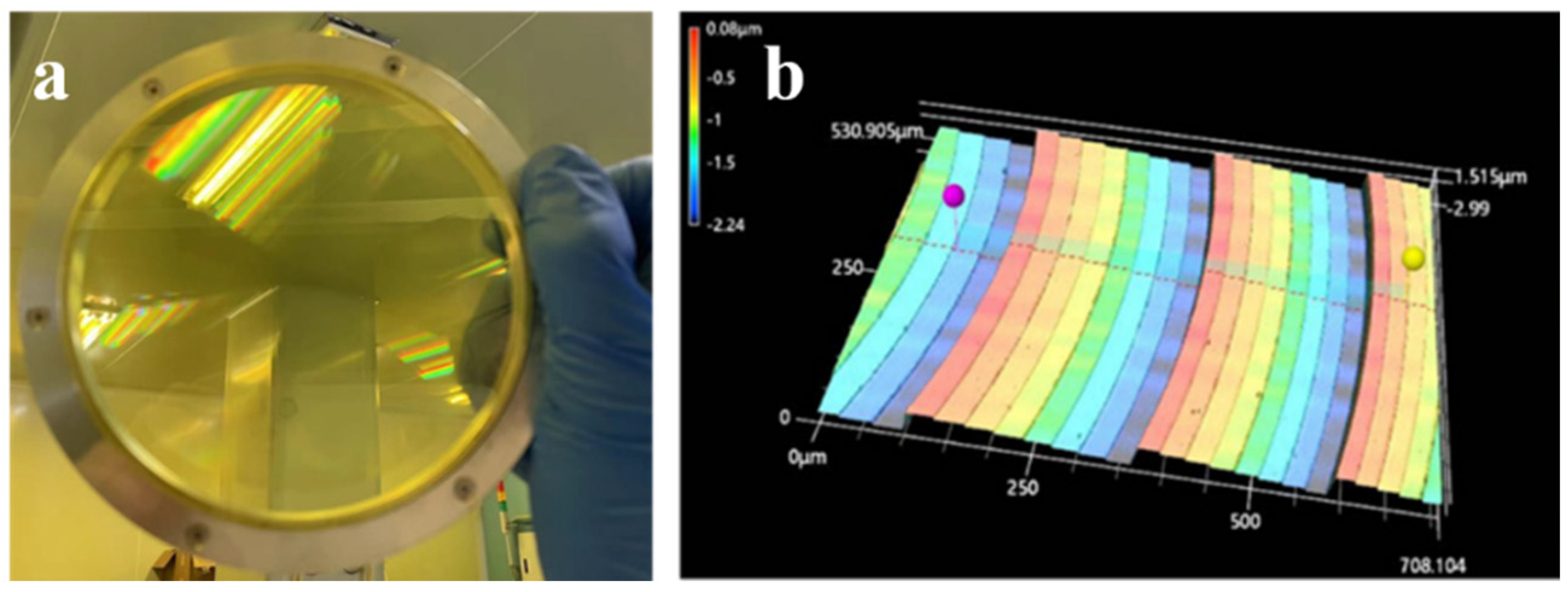Laser Radar System Based on Lightweight Diffractive Lens Receiver System
Abstract
1. Introduction
2. Materials and Methods
2.1. Diffractive Lens
2.2. Receiver System
2.3. Laser Radar Distance Test System
3. Results and Discussion
3.1. The Design of the Lightweight Diffractive Lens
3.2. The Fabrication and Performance of Eight-Level Diffractive Lens
3.3. Distance Test
4. Conclusions
Author Contributions
Funding
Institutional Review Board Statement
Informed Consent Statement
Data Availability Statement
Conflicts of Interest
References
- Yu, A.W.; Krainak, M.; Harding, D.J.; Abshire, J.B.; Sun, X.; Cavanaugh, J.F.; Valett, S.R.; Ramos-Izquierdo, L. Multi-beam laser altimeter system simulator for the LIDAR surface topography (LIST) mission. Laser Electro-Opt. 2012, 1509, 1–3. [Google Scholar]
- Gargoum, S.; El-Basyouny, K. Automated extraction of road features using LiDAR data: A review of LiDAR applications in transportation. In Proceedings of the 2017 4th International Conference on Transportation Information and Safety (ICTIS), Banff, AB, Canada, 8–10 August 2017; pp. 563–574. [Google Scholar]
- Winker, D.M.; Couch, R.H.; McCormick, M.P. An overview of LITE: NASA’s LIDAR in-space technology experiment. Proc. IEEE 1996, 84, 1835. [Google Scholar] [CrossRef]
- Brenner, A.C.; DiMarzio, J.P.; Zwally, H.J. Precision and accuracy of satellite radar and laser altimeter data over the continental ice sheet. Geosci. Remote Sens. 2007, 45, 321–331. [Google Scholar] [CrossRef]
- Serre, D.; Deba, P.; Koechlin, L. Fresnel interferometric imager: Ground-based prototype. Appl. Opt. 2009, 48, 2811–2820. [Google Scholar] [CrossRef]
- Raksasataya, T.; Deba, P.; Rivet, J.P.; Gili, R.; Serre, D.; Koechlin, L. Fresnel diffractive imager: Instrument for space mission in the visible and UV. Proc. SPIE 2010, 7732, 10. [Google Scholar]
- Grams, G.W.; Wyman, C.M. Measurements of stratospheric aerosols by airborne laser radar. J. Appl. Meteorol. Climatol. 1972, 11, 1108–1113. [Google Scholar] [CrossRef]
- De young, R.J.; Anthony, N.; Carrion, W.; Pliutau, D. Lightweight Inexpensive Ozone LIDAR Telescope Using a Plastic Fresnel Lens; NASA/TM-2014-218534; National Aeronautics & Space Administration: Washington, DC, USA, 2014.
- Zhu, J.; Xie, Y. Large aperture diffractive telescope design for space-based LIDAR receivers. Proc. SPIE 2015, 9795, 43–48. [Google Scholar]
- Li, D.J.; Gao, J.H.; Cui, A.J.; Zhou, K.; Wu, J. Research on space-borne dual-wavelength land-sea LIDAR system with 2m diffractive aperture. Chin. J. Lasers 2022, 49, 0310001. [Google Scholar]
- Gao, J.H.; Li, D.J.; Zhou, K.; Cui, A.; Wu, J.; Wang, Y.; Liu, K.; Tan, S.; Gao, Y.; Yao, Y. Analysis of receiving beam broadening and detection range of LIDAR based on diffractive optical system. Chin. J. Lasers 2023, 50, 0510001. [Google Scholar]
- Sangyoon, P.; Gwangmook, K.; Sehwan, C. Near-field sub-diffraction photolithography with an elastomeric photomask. Nat. Commun. 2020, 11, 805. [Google Scholar]
- Zhang, J.; Con, C.; Cui, B. Electron beam lithography on irregular surfaces using an evaporated resist. ACS Nano 2014, 8, 3483–3489. [Google Scholar] [CrossRef]
- James, L.; Dilan, R.; Curtis, M. Grayscale lithography—Automated mask generation for complex three-dimensional topography. J. Micro/Nanolithography MEMS MOEMS 2016, 15, 013511. [Google Scholar]
- Ni, H.; Yuan, G.; Sun, L.; Chang, N.; Zhang, D.; Chen, R.; Jiang, L.; Chen, H.; Gu, Z.; Zhao, X. Large-scale high-numerical-aperture super-oscillatory lens fabricated by direct laser writing lithography. R. Soc. Chem. Adv. 2018, 8, 20117–20123. [Google Scholar] [CrossRef]
- Osipov, V.P.; Doskolovich, L.L.; Bezus, E.A.; Drew, T.; Zhou, K.; Sawalha, K.; Swadener, G.; Wolffsohn, J.S.W. Application of Nanoimprinting Technique for Fabrication of Trifocal Diffractive Lens with Sine-like Radial Profile. J. Biomed. Opt. 2015, 20, 025008. [Google Scholar] [CrossRef]
- Furlan, W.D.; Ferrando, V.; Monsoriu, J.A.; Zagrajek, P.; Czerwińska, E.; Szustakowski, M. 3D printed diffractive terahertz lenses. Opt. Lett. 2016, 41, 1748–1751. [Google Scholar] [CrossRef]
- Jang, C.; Mercier, O.; Bang, K.; Li, G.; Zhao, Y.; Lanman, D. Design and fabrication of freeform holographic optical elements. ACM Trans. Graph. 2020, 39, 1–15. [Google Scholar] [CrossRef]
- Svetlana, N.K.; Nikolay, L.K.; Muhammad, A.B. Grayscale Lithography and a Brief Introduction to Other Widely Used Lithographic Methods: A State-of-the-Art Review. Micromachines 2024, 15, 1321. [Google Scholar] [CrossRef]
- Shi, C.; Zhao, W.; Chen, S.; Li, W. Multilevel Diffractive Lenses: Recent Advances and Applications. Symmetry 2024, 16, 1377. [Google Scholar] [CrossRef]
- Liu, X.; Li, M.; Li, B.; Fan, B. Membrane Fresnel Diffractive Lenses with High-Optical Quality and High-Thermal Stability. Polymers 2022, 14, 3056. [Google Scholar] [CrossRef]
- Alda, J.; Rico-García, J.M.; López-Alonso, J.M.; Lail, B.; Boreman, G. Design of Fresnel lenses and binary staircase kinoforms of low value of the aperture number. Opt. Commun. 2006, 260, 454–461. [Google Scholar] [CrossRef]
- Yin, J.; Mao, D.; Fan, B. Copolyamide-Imide Membrane with Low CTE and CME for Potential Space Optical Applications. Polymers 2021, 13, 1001. [Google Scholar] [CrossRef] [PubMed]
- Yin, J.; Hui, H.; Fan, B.; Bian, J.; Du, J.; Yang, H. Preparation and Properties of Polyimide Composite Membrane with High Transmittance and Surface Hydrophobicity for Lightweight Optical System. Membranes 2022, 12, 592. [Google Scholar] [CrossRef]
- Gao, G.; Wang, L.; Shi, H.; Liu, D.; Fan, B.; Guan, C. Facile Large Area Uniform Photolithography of Membrane Diffractive Lens Based on Vacuum Assisted Self Contact Method. Sci. Rep. 2020, 10, 9005. [Google Scholar] [CrossRef]
- Li, Z.; Liu, B.; Wang, H.; Yi, H.; Chen, Z. Advancement on target ranging and tracking by single-point photon counting lidar. Opt. Express 2022, 30, 29907–29922. [Google Scholar] [CrossRef] [PubMed]
- Moreno, I.; Gutierrez, B.K.; Sánchez-López, M.M.; Davis, J.A.; Khanal, H.P.; Cottrell, D.M. Diffraction efficiency of stepped gratings using high phase-modulation spatial light modulators. Opt. Lasers Eng. 2020, 126, 105910. [Google Scholar] [CrossRef]
- Levy, U.; Mendlovic, D.; Marom, E. Efficiency analysis of diffractive lenses. J. Opt. Soc. Am. A Opt. Image Sci. Vis. 2001, 18, 86–93. [Google Scholar] [CrossRef]








| Parameter | Eight Levels | Four Levels | Two Levels |
|---|---|---|---|
| Effective aperture (mm) | 50 | 50 | 50 |
| Working wavelength (nm) | 1064 | 1064 | 1064 |
| Focus (mm) | 300 | 300 | 300 |
| Smallest linewidth (μm) | 1.6 | 3.2 | 6.4 |
| Etching depth of each level (nm) | 290 | 590 | 1180 |
| Theoretical diffraction efficiency | 94.78% | 80.96% | 40.53% |
Disclaimer/Publisher’s Note: The statements, opinions and data contained in all publications are solely those of the individual author(s) and contributor(s) and not of MDPI and/or the editor(s). MDPI and/or the editor(s) disclaim responsibility for any injury to people or property resulting from any ideas, methods, instructions or products referred to in the content. |
© 2025 by the authors. Licensee MDPI, Basel, Switzerland. This article is an open access article distributed under the terms and conditions of the Creative Commons Attribution (CC BY) license (https://creativecommons.org/licenses/by/4.0/).
Share and Cite
Yin, J.; Hou, M.; Fan, B.; Bian, J.; Du, J. Laser Radar System Based on Lightweight Diffractive Lens Receiver System. Photonics 2025, 12, 86. https://doi.org/10.3390/photonics12010086
Yin J, Hou M, Fan B, Bian J, Du J. Laser Radar System Based on Lightweight Diffractive Lens Receiver System. Photonics. 2025; 12(1):86. https://doi.org/10.3390/photonics12010086
Chicago/Turabian StyleYin, Jiajia, Mengxia Hou, Bin Fan, Jiang Bian, and Junfeng Du. 2025. "Laser Radar System Based on Lightweight Diffractive Lens Receiver System" Photonics 12, no. 1: 86. https://doi.org/10.3390/photonics12010086
APA StyleYin, J., Hou, M., Fan, B., Bian, J., & Du, J. (2025). Laser Radar System Based on Lightweight Diffractive Lens Receiver System. Photonics, 12(1), 86. https://doi.org/10.3390/photonics12010086






